
Olive Oyl is a cartoon character created by E. C. Segar in 1919 for his comic strip Thimble Theatre. The strip was later renamed Popeye after the sailor character that became the most popular member of the cast; however, Olive Oyl was a main character for a decade before Popeye's 1929 appearance.

Bluto, at times known as Brutus, is a cartoon and comics character created in 1932 by Elzie Crisler Segar as a one-time character, named "Bluto the Terrible", in his Thimble Theatre comic strip. Bluto made his first appearance on September 12 of that year. Fleischer Studios adapted him the next year (1933) to be the main antagonist of their theatrical Popeye animated cartoon series.
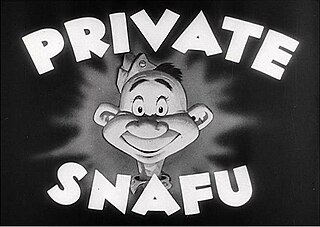
Private Snafu is the title character of a series of black-and-white American instructional adult animated shorts, ironic and humorous in tone, that were produced between 1943 and 1945 during World War II. The films were designed to instruct service personnel about security, proper sanitation habits, booby traps and other military subjects, and to improve troop morale. Primarily, they demonstrate the negative consequences of doing things wrong. The main character's name is a play on the military slang acronym SNAFU, "Situation Normal: All Fucked Up". The cleaned-up version of that phrase, usually used on radio and in print, was "Situation Normal: All Fouled Up".

The Fleischer Superman cartoons are a series of seventeen animated superhero short films released in Technicolor by Paramount Pictures and based upon the comic book character Superman, making them his first animated appearance.
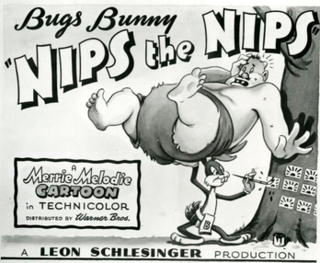
Bugs Bunny Nips the Nips is a 1944 Merrie Melodies cartoon directed by Friz Freleng. The cartoon, released on April 22, 1944, features Bugs Bunny. The film depicts Bugs fighting against the Imperial Japanese Army in the Pacific War. The film is considered controversial for caricaturing the Japanese enemy, and expressing anti-Japanese sentiment.
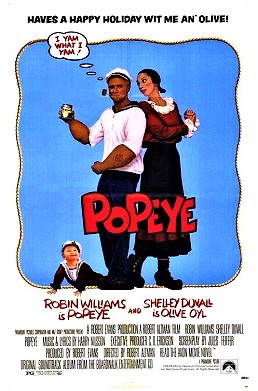
Popeye is a 1980 American musical comedy film directed by Robert Altman and produced by Paramount Pictures and Walt Disney Productions. It is based on E. C. Segar's Popeye comics character. The script was written by Jules Feiffer, and stars Robin Williams as Popeye the Sailor Man and Shelley Duvall as Olive Oyl. Its story follows Popeye's adventures as he arrives in the town of Sweethaven.

Popeye the Sailor Meets Sindbad the Sailor is a 1936 two-reel animated cartoon short subject in the Popeye Color Specials series, produced in Technicolor and released to theatres on November 27, 1936, by Paramount Pictures. It was produced by Max Fleischer for Fleischer Studios, Inc. and directed by Dave Fleischer, with the title song's music composed by Sammy Timberg and lyrics written by Bob Rothberg. The voice cast includes Jack Mercer as Popeye, Gus Wickie as Sindbad the Sailor, Mae Questel as Olive Oyl and Lou Fleischer as J. Wellington Wimpy.
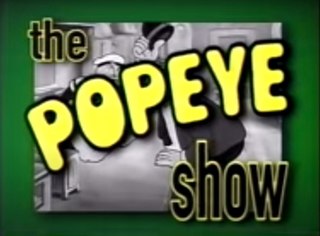
The Popeye Show is an American cartoon anthology series that premiered on October 29, 2001, on Cartoon Network. Each episode includes three Popeye theatrical shorts from Fleischer Studios and/or Famous Studios. The show is narrated by Bill Murray, who gives the audience short facts about the history of the cartoons as filler material between each short. Animation historian Jerry Beck served as a consultant and Barry Mills served as writer and producer. A total of 45 episodes were produced, consisting of a total of 135 shorts.
Swee'Pea is a character in E. C. Segar's comic strip Thimble Theatre/Popeye and in the cartoon series derived from it. His name refers to the flower known as the sweet pea. Before his addition to the animated shorts, the name "Sweet Pea" was a term of affection used by main character Popeye. In the cartoon We Aim to Please, he addressed girlfriend Olive Oyl that way.

Momotarō no Umiwashi is an animated Japanese propaganda film produced in 1942 by Geijutsu Eigasha and released March 25, 1943. Running at 37 minutes, it was close to being feature-length, but it was not the first animated feature film in Asia that honor goes to China's 1941 Princess Iron Fan, which was 73 minutes long. A DVD version without English subtitles was released in Japan by Kinokuniya Shoten in 2004; one with subtitles was released in the United States by Zakka Films in 2009.
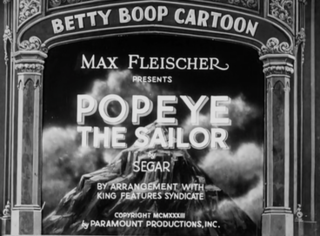
Popeye the Sailor is a 1933 animated short produced by Fleischer Studios and distributed by Paramount Publix Corporation. While billed as a Betty Boop cartoon, it was produced as a vehicle for Popeye in his debut animated appearance.
This is a list of the 122 cartoons of the Popeye the Sailor film series produced by Famous Studios for Paramount Pictures from 1942 to 1957, with 14 in black-and-white and 108 in color. These cartoons were produced after Paramount took ownership of Fleischer Studios, which originated the Popeye series in 1933.

Popeye the Sailor is an American animated television series produced for King Features Syndicate TV starring Popeye that was released between 1960 and 1963 with 220 episodes produced. The episodes were produced by a variety of production studios and aired in broadcast syndication until the 1990s.

Popeye the Sailor is an American animated series of short films based on the Popeye comic strip character created by E. C. Segar. In 1933, Max and Dave Fleischer's Fleischer Studios, based in New York City, adapted Segar's characters into a series of theatrical cartoon shorts for Paramount Pictures. The plotlines in the animated cartoons tended to be simpler than those presented in the comic strips, and the characters slightly different. A villain, usually Bluto, makes a move on Popeye's "sweetie", Olive Oyl. The villain clobbers Popeye until he eats spinach, giving him superhuman strength. Thus empowered, Popeye makes short work of the villain.

You're a Sap, Mr. Jap is a 1942 one-reel anti-Japanese Popeye the Sailor animated cartoon short subject released by Paramount Pictures on August 7, 1942. It was the first cartoon short to be produced by Famous Studios. It is one of the best-known World War II propaganda cartoons.

Popeye the Sailor is a fictional cartoon character created by Elzie Crisler Segar. The character first appeared on January 17, 1929, in the daily King Features comic strip Thimble Theatre. The strip was in its tenth year when Popeye made his debut, but the one-eyed sailor quickly became the lead character, and Thimble Theatre became one of King Features' most popular properties during the 1930s. Following Segar's death in 1938, Thimble Theatre was continued by several writers and artists, most notably Segar's assistant Bud Sagendorf. It was formally renamed Popeye. The strip continues to appear in first-run installments on Sundays, written and drawn by R.K. Milholland. The daily strips are reprints of old Sagendorf stories.

Spinach Fer Britain is a 1943, anti-Nazi propaganda cartoon, produced by Famous Studios and distributed by Paramount Pictures. The film centers around Popeye the Sailor trying to deliver a shipment of spinach to 10 Downing Street in London, while fighting off Nazi Kriegsmarine soldiers pursuing him in a U-boat. The short was released on January 22, 1943.
Take Heed Mr. Tojo is a 1943 American animated short film directed by Shamus Culhane. It is an American World War II propaganda film featuring the character Hook, who was a character similar to Private Snafu at the Warner Brothers' animation department.
World War II changed the possibilities for animation. Prior to the war, animation was mostly seen as a form of family entertainment. The attack on Pearl Harbor was a turning point in its utility. On December 8, 1941, the United States Army began working with Walt Disney at his studio, stationing Military personnel there for the duration of the war. The Army and Disney set about making various types of films for several different audiences. Most films meant for the public included some type of propaganda, while films for the troops included training and education about a given topic.

Commando Duck is a Walt Disney anti-Japanese propaganda cartoon starring Donald Duck. It was released on June 2, 1944.
















